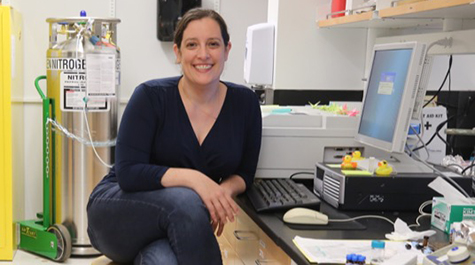Using a CAREER Award to take a long-term look at our atmosphere’s chemistry
It took a pandemic for the world to understand the importance of something Rachel O’Brien has been researching for the better part of two decades.
O’Brien, an assistant professor in William & Mary’s Department of Chemistry, is an expert on tiny airborne particles known as aerosols. Aerosols are created when fine solid bits or teeny liquid droplets are suspended in air or another gas. Dust, haze and smoke are all examples of aerosols – as are the exhaled droplets that transmit the virus responsible for causing COVID-19.
Yet viruses are just a small part of our worries when it comes to harmful substances carried by aerosols, O’Brien explained. Molecules such as carbon, carried by aerosols in the atmosphere, can have large impacts on climate, air quality, human health and the environment.
The Earth’s atmosphere is a mixture of gases and particles. Some float around just as they are and others are chemically formed in interactions that occur within the atmosphere itself. O’Brien is particularly interested in the secondary, or even tertiary effects of such atmospheric chemical interactions.
She’s working to understand interactions sparked by compounds of carbon-based material found in aerosol particles, and even in later interactions, created when particles drift down and are deposited on outdoor surfaces.
“In atmospheric chemistry laboratory studies, we often focus on initial reaction paths and products, but what comes next?” she said. “Aerosol particles and deposited films can exist in the environment for one to two weeks, or more.”
O’Brien recently received a five-year CAREER award from the National Science Foundation to continue her research, which she is doing with a team of undergraduate W&M students, two masters students and a third graduate student joining the group in the fall.
The NSF awards CAREER funding to “early-career faculty who have the potential to serve as academic role models in research and education and to lead advances in the mission of their department or organization.”
The objective of the team’s project is to measure the extent and impact of multi-generational aging reactions in complex organic mixtures. Essentially, they are going to take a long-term look at atmospheric chemical changes caused by aerosolized carbon and carbon-based molecules, which primarily result from fossil fuel emissions and biomass burning.
“Knowledge about the types and extents of slower aging reactions is key to understanding and predicting the behaviors of carbon mixtures in the atmospheric aerosols,” O’Brien explained. “By designing longer-term aging experiments, a more complete view of the full aging process can be obtained, providing important insights into the fraction of organic carbon that remains in the condensed phase compared to the fraction that volatilizes.”
One of the goals of the research, O’Brien explained, is to develop a more accurate way to estimate the fraction of carbon emitted into the atmosphere that stays in the condensed phase, both in aerosol and in surface films, as the aerosol ages. This will help scientists develop better models for predicting degradations in air quality and changes in the Earth’s climate.
The findings from O’Brien’s lab will also inform the surrounding community with the help of W&M’s chapter of the National Organization of Black Chemists and Chemical Engineers, which is mentored by fellow chemistry department faculty member Dana Lashley. NOBCChE student members will conduct outreach activities that promote chemistry and scientific studies in the local community.
Another central goal for O’Brien is to attract, retain and support students in the atmospheric sciences. She plans to partner with local high schools, such as Bruton High, over the coming year to develop curriculum and learning experiences related to air pollution.
“Focusing on organic material deposited onto surfaces provides a rich platform for questions that have immediate ties to students’ experiences in everyday life,” she said.















